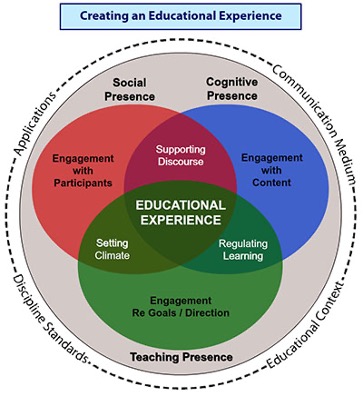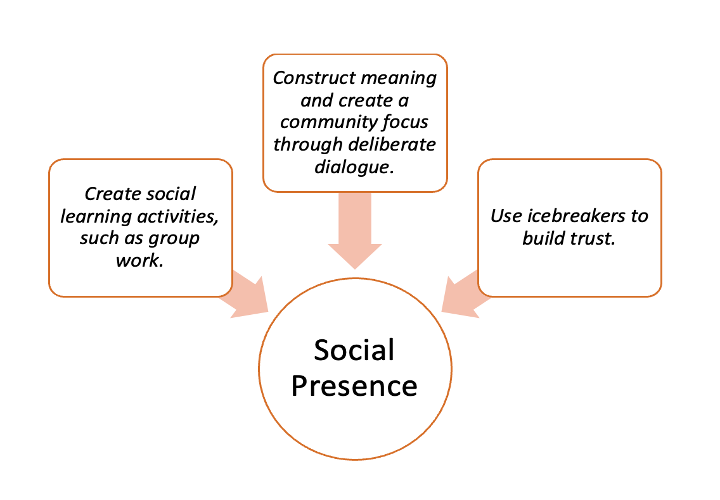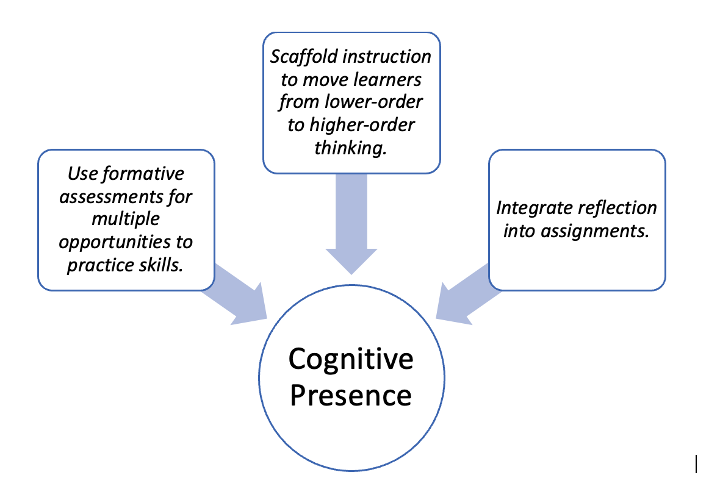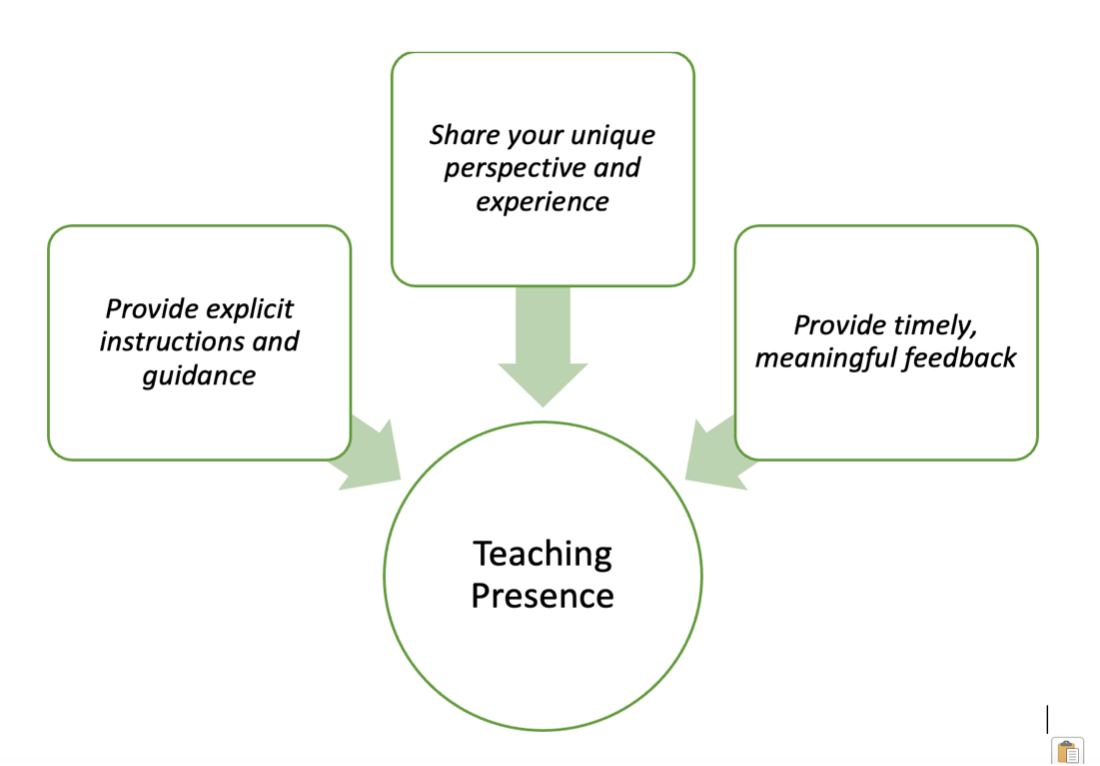The Importance of Building a Community of Inquiry in Your Online Course
This guest post is by Mia Lamm, Senior Instructional Designer at the Center for Teaching and Learning.
Community of Inquiry (CoI) is one of the most widely used models for building online learning communities (Garrison, 2000). It is a collaborative-constructionist framework based on the intersection of social, cognitive, and teaching presences. The framework was developed from a study by Dr. Randy Garrison, Dr. Terry Anderson, and Dr. Walter Archer.

(Garrison, Anderson, & Archer, 2000)
What is an Educational CoI?
An educational CoI can be defined as a group of learners invested in reflective, critical dialogue with their peers and instructors through various instructional activities. Creating a CoI in online courses can help overcome the potential isolation and lack of interaction in fully online environments. By working together, learners develop a deeper understanding of the course material, challenge their assumptions through multiple perspectives, and engage in higher-order thinking. In short, CoI is a theoretical, evidence-based framework for positively influencing learner experience in an online course.
Elements of COI in Course Design
Instructors – By applying this framework as a lens during the course design process, instructional strategies will reflect inquiry principles involving questioning, exploration, and reflection. Designing a Community of Inquiry requires consideration of seven principles (Garrison, 2019):
- Plan for the creation of open communication and trust
- Plan for critical reflection and discourse
- Establish community and cohesion
- Establish inquiry dynamics (purposeful inquiry)
- Sustain respect and responsibility
- Sustain inquiry that moves to resolution
- Ensure assessment is congruent with intended processes and outcomes
Learners — When learners join a course, they become part of a learning community. A learning community has an instructor, content to process, and students who are both participants and peers. Learners typically have two key roles: 1) to maintain a cognitive presence – a continual process of critical thinking, and 2) to develop a social presence – creating relationships that allow learning and collaboration.
How to Build a CoI
To build a positive and robust learning community, you will want to create a safe space and a sense of belonging for the students involved.
Consider the three primary forms of interaction:
- Student – Teacher
- Student – Student
- Student – Content
How will your learners interact? What does it look like, what do they use, and how successful does it seem?
Developing a Social Presence in Your Course
Social Presence refers to the connection of learners with the other people in the course or program, creating a sense of trust, community, and belonging. Interaction and cohesive expression are indicators of a successful social presence (Univ of Oregon, n.d.) This can be achieved through icebreaker activities, discussion forums, group projects, and other interactive experiences encouraging communication and collaboration.

Developing Cognitive Presence in Your Course
Cognitive Presence consists of four phases to support the critical thinking process (Garrison, 2019):
- Triggering event: a problem or scenario is presented to learners
- Exploration: learners attempt to identify the nature of the problem
- Integration: the information from the exploration phase is applied to the problem to provide context and meaning
- Resolution: a solution is selected
This can be achieved by helping learners to develop critical thinking skillsthrough purposeful inquiry. This is done through all phases of learning, including building and consuming information, reflection, and problem-solving applications.

Developing a Teaching Presence in Your Course
Teaching presence is a significant factor in student satisfaction and perceived learning. Design (expectations, responsibility, accountability, assessment, and processes), facilitation, and direct instruction are parts of teaching presence. Providing clear learning objectives, meaningful learning materials, and timely feedback can help to create a positive and supportive learning environment that promotes open communication, respect for diverse perspectives, and a shared commitment to learning. (University of Denver, n.d.) A deeper dive into course design can be found on the CTL Teaching Toolkit site.

Conclusion
In summary, the CoI framework can guide the creation of positive and collaborative learning communities. This framework is valuable for establishing and sustaining online learning experiences. When people engage in dialogue with others with diverse backgrounds and perspectives, they must learn to listen, articulate their thoughts, and respond thoughtfully to others’ ideas. These skills are valuable in many academic, professional, and personal contexts. In the big picture, building a community of inquiry is important because it can promote collaboration, create a supportive learning environment, and help individuals develop essential skills for lifelong learning.
Want to learn more about the Community of Inquiry? I recommend starting here:
The Community of Inquiry Framework
The CTL (Center for Teaching and Learning) Instructional Design team is here to help! If you would like to schedule a consult appointment, please contact CTL Help at ctlhelp@jhu.edu
References
Community of Inquiry. (n.d.). About the framework: Social, cognitive, and teaching presence. Retrieved May 8, 2023, from https://www.thecommunityofinquiry.org/framework
Community of Inquiry Model, Denver - University of Denver. (n.d.). Retrieved from https://operations.du.edu/inclusive-teaching/community-inquiry-model
Creating a Community of Inquiry in Online Classes, Teaching Support and Innovation. (n.d.). Teaching.uoregon.edu. https://teaching.uoregon.edu/COI
Garrison, R., Anderson, T., & Archer, W. (2000). “Critical inquiry in a text-based environment: Computer conferencing in higher education model.” (“Theoretical frameworks and conferencing tools – Conferencing Tools for …”) The Internet and Higher Education, 2(2-3), 87–105.
Garrison, R. (2019). Design principles. The Community of Inquiry. https://www.thecommunityofinquiry.org/editorial18